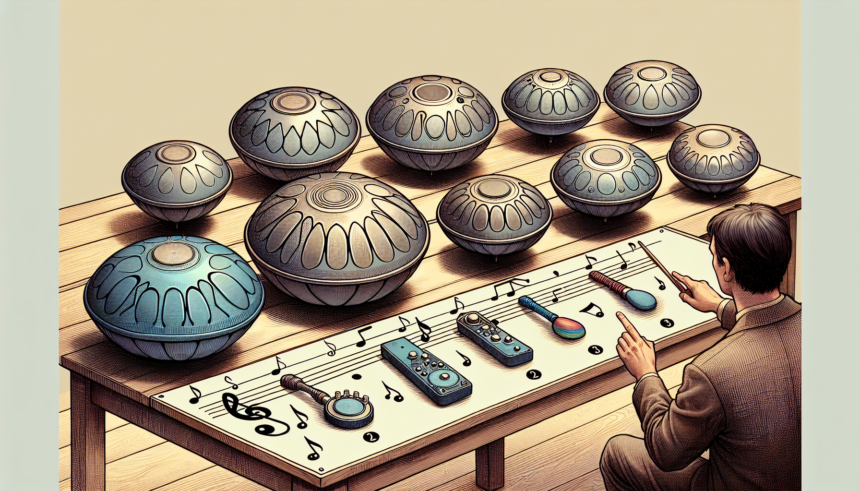Handpans have gained popularity among musicians for their ethereal sound and intuitive playability. As handpans become more popular in various performance and recording settings, the need to amplify their sound accurately has grown. That’s where handpan pickups come in. But with several options available in the market, making a choice can be daunting. This article will compare different handpan pickups, helping you decide which one is right for you.
Understanding Handpan Pickups
Handpan pickups are devices designed to capture the sound of your handpan and transform it into an electrical signal that can be amplified. There are various types of pickups, each with its strengths and weaknesses. The goal is to pick a pickup that captures the authentic resonance and warmth of your instrument without compromising its tonal quality.
Clip-on Microphones
Clip-on microphones are a popular option among handpan players for their simplicity and convenience. These mics clip onto the rim of the handpan, close to the sound source.
- Pros: Easy to mount and adjust; typically provide a natural sound; portable and unobtrusive.
- Cons: May pick up unwanted ambient noise; can be prone to feedback in loud environments.
The DPA 4099 is a well-known example. It’s known for its high fidelity and accurate sound reproduction. However, it comes with a higher price tag, which might be a consideration for some players.
Contact Microphones
Contact microphones or piezo pickups are attached directly to the surface of the handpan. They pick up vibrations from the instrument’s body rather than the air vibrations.
- Pros: Reduced feedback compared to clip-on mics; captures detailed nuances of the instrument’s vibrations; usually less expensive.
- Cons: Can be trickier to install; may require a preamp for optimal sound quality.
The K&K Sound Big Shot is a popular piezo pickup, known for its robust build and excellent vibration capture. While it might take some trial and error to find the best placement on your handpan, the effort pays off in sound clarity and fidelity.
Hybrid Systems
Hybrid systems combine elements of both clip-on and contact microphones, aiming to capture the best of both worlds.
- Pros: Versatile; can provide a well-rounded capture of both the instrument’s resonance and ambient nuances; may include multiple channels for more control over the sound.
- Cons: More complex setup; usually on the higher end of the price spectrum.
For example, the Schertler Basik Set is praised for its versatility and sound quality, though its sophistication means it’s often reserved for professional use or seasoned players looking for optimal sound control.
Factors to Consider
When choosing a handpan pickup, several factors come into play:
Sound Quality
Your primary goal is to capture the true sound of your handpan. Therefore, sound quality is paramount. Listen to demo recordings of different pickups and, if possible, try them out in a store. Pay close attention to how well the pickup captures the nuances of your handpan’s tones and harmonics.
Environment
Consider where you will be primarily using your pickup. If you’re playing in a noisy or feedback-prone environment, a contact microphone might be a better choice. Conversely, if you’re in a controlled studio setting, the detailed sound of a clip-on mic might be preferable.
Installation and Usage
Think about how easy the pickup is to install and use. Clip-on mics are generally simpler to set up, while contact mics may require more time and effort to find the optimal position. Hybrid systems might need more technical know-how but offer greater flexibility.
Budget
Handpan pickups come in a wide range of prices. Set a budget that matches your needs and stick to it. Remember that sometimes paying a little more can result in significantly better sound quality and durability, but there are also plenty of reasonably priced options that don’t skimp on performance.
Durability
Especially if you plan to travel with your handpan, choose a durable pickup that can withstand some wear and tear. Check reviews for information on the build quality and lifespan of different models.
Popular Handpan Pickups Compared
DPA 4099
The DPA 4099 is a high-end clip-on microphone known for its exceptional sound quality. It has a gooseneck design, allowing for precise placement, and it captures a wide frequency range.
- Pros: Exceptional sound quality; easy to attach and position; highly durable.
- Cons: Expensive; may pick up ambient noise in less controlled environments.
K&K Sound Big Shot
The K&K Sound Big Shot is a piezo pickup that attaches directly to the surface of the handpan. It’s highly sensitive to vibrations, offering excellent tonal clarity.
- Pros: Affordable; captures detailed vibrations; minimizes feedback.
- Cons: Installation can be tricky; might require a preamp for best results.
Schertler Basik Set
The Schertler Basik Set is a hybrid system designed for versatility and high-quality sound capture. It includes a piezo contact mic and a preamp, offering multiple channels for comprehensive sound control.
- Pros: Versatile; high sound quality; offers multiple sound control options.
- Cons: Expensive; more complex setup than other options.
Internal Pickups
Some handpans come with internal pickups, custom-installed by the manufacturer. These are usually contact mics embedded within the instrument during its construction.
- Pros: Tailored specifically for the instrument; minimal setup required; seamless integration.
- Cons: Generally more expensive; limited to built-in designs.
Meinl Pickup
The Meinl Pickup is another popular contact microphone known for its ease of use and reliable performance. It’s designed with an adhesive pad for easy attachment and removal.
- Pros: Affordable; easy to attach and remove; reliable performance.
- Cons: May not capture as much detail as higher-end models; adhesive might wear out over time.
Conclusion
Choosing the right handpan pickup depends on various factors, including your environment, budget, and specific needs. While clip-on microphones like the DPA 4099 offer exceptional sound quality, they can be more susceptible to ambient noise. On the other hand, contact microphones such as the K&K Sound Big Shot provide excellent vibration capture with reduced feedback but may require careful installation.
Hybrid systems like the Schertler Basik Set offer a balanced approach but come at a higher price point and with more complex setup requirements. Internal pickups provide effortless integration and are tailored for the instrument, though they are generally more expensive and limited to built-in designs.
Ultimately, the best pickup for you is one that meets your specific needs and enhances your playing experience, whether in a live setting or a recording studio. Take the time to research and test different options to find the perfect match for your handpan.
FAQs
1. Can I use a regular microphone for my handpan?
While it’s possible to use a regular microphone, handpan pickups are specifically designed to capture the unique resonance and tonal qualities of the handpan. Regular microphones might not provide the same level of detail and clarity.
2. Do I need a preamp for my handpan pickup?
Some pickups, particularly piezo contact microphones, might benefit from a preamp to enhance their sound quality and output level. However, this depends on the specific pickup model and your sound system.
3. How do I minimize feedback when using a handpan pickup?
Minimizing feedback involves proper placement of the pickup, using a preamp if necessary, and adjusting your sound system settings. Contact microphones usually have less feedback compared to clip-on microphones.
4. Are there wireless handpan pickups available?
Yes, some pickups offer wireless systems, which can be convenient for live performances. However, wired pickups often provide more reliable sound quality.
5. How durable are handpan pickups?
The durability of handpan pickups varies by model and brand. High-end pickups like the DPA 4099 are known for their robust construction, while more affordable options might require more careful handling. Always check user reviews and product descriptions for durability information.





